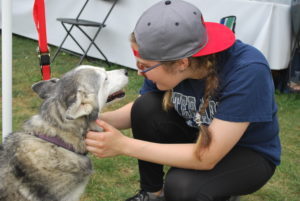Main Content

Is he asking to play? Or is he scared? How do you know what a dog is trying to say? Dogs tell us how they are feeling through their body language and vocalization. Some cues are easy for us to understand while others can be confusing. Is she barking because she’s excited or because she’s upset? Is he standing still because he’s relaxed or because he’s afraid? 4-H dog project members work with their club trainers to recognize and understand the many subtle cues dogs send us so we can better communicate with our furry friends. The following are some ideas used by New Jersey 4-H dog clubs to help new club members and the general public strengthen their dog language skills.
Start by asking the group for ways dogs communicate their feelings. Suggestions could include behavior (jumping, play bow, roll over, run away), specific body changes (position of tail/ears, panting, raised hackles), or vocal cues (barking, whimpering, growling). For a younger audience, ask participants to act out what these cues look like. Keep a list of the group’s suggestions. Then, ask the group to decide whether they think each cue is positive (safe to approach dog), negative (not safe to approach), or if they are unsure. More than likely, the group will struggle to make a selection since many cues on their own are not enough to tell us how the dog is feeling. For example, a dog rolled over on her back may be relaxed and inviting a tummy rub. Or she could be scared and trying to show she is not a threat, but may bite if touched.

Next, give the group a lot of pictures of dogs showing different body cues. Use as many different dog breeds as possible to help participants recognize cues across all breeds. It is also important to show positive and negative cues in all breeds to avoid stereotyping specific breeds as “safe” or “unsafe”. Remind participants that all dogs (regardless of breed) can be friendly or unfriendly. Place emojis around the room representing feelings of happy, calm, silly, scared, worried, and angry. Ask the participants to place the dog pictures next to the emoji they think best represents what that dog is trying to say. Then, as a group, review the pictures with each emoji. What does a silly dog look like versus a worried dog? Be sure to ask the group which emojis represent dogs that would be considered safe or unsafe to approach.
If possible, have a calm dog assist you with this next activity. Often times, people of all ages are excited when meeting a new dog and forget basic etiquette. Review with participants the proper steps to greet a new dog which include 1) asking for permission from the handler, 2) holding out your closed hand for the dog to approach and sniff, 3) gently petting the dog ONLY if the dog is relaxed. Have the participants one-by-one practice these steps by greeting the assistant dog. It will feel silly to hear each person ask to pet an obviously friendly dog, but it will help reinforce proper etiquette.
Now that the group knows when and how to approach a dog, explore some different scenarios where they might encounter an unknown dog. Ideas for scenarios include what to do when you find a dog off-leash, an injured dog, or a pack of dogs. Remind participants not to approach a dog they do not know, remain calm and quiet, and slowly back away. They should tell an adult immediately in any of these situations.
For more information on understanding dog behavior, be sure to check out the American Kennel Club‘s article “How to Read Dog Body Language“. Another article by moderndog magazine titled “How to Read Your Dog’s Body Language” offers labeled visuals to help break down the many cues the dog is sending. Doggone Safe challenges viewers to spot the warning signs of a dog about to bite. This quick video is a great visual to understand that the reactions that seem to come out of nowhere started with missed signals from an unhappy dog.
By Kelly Dziak, 4-H Program Associate, Rutgers Cooperative Extension